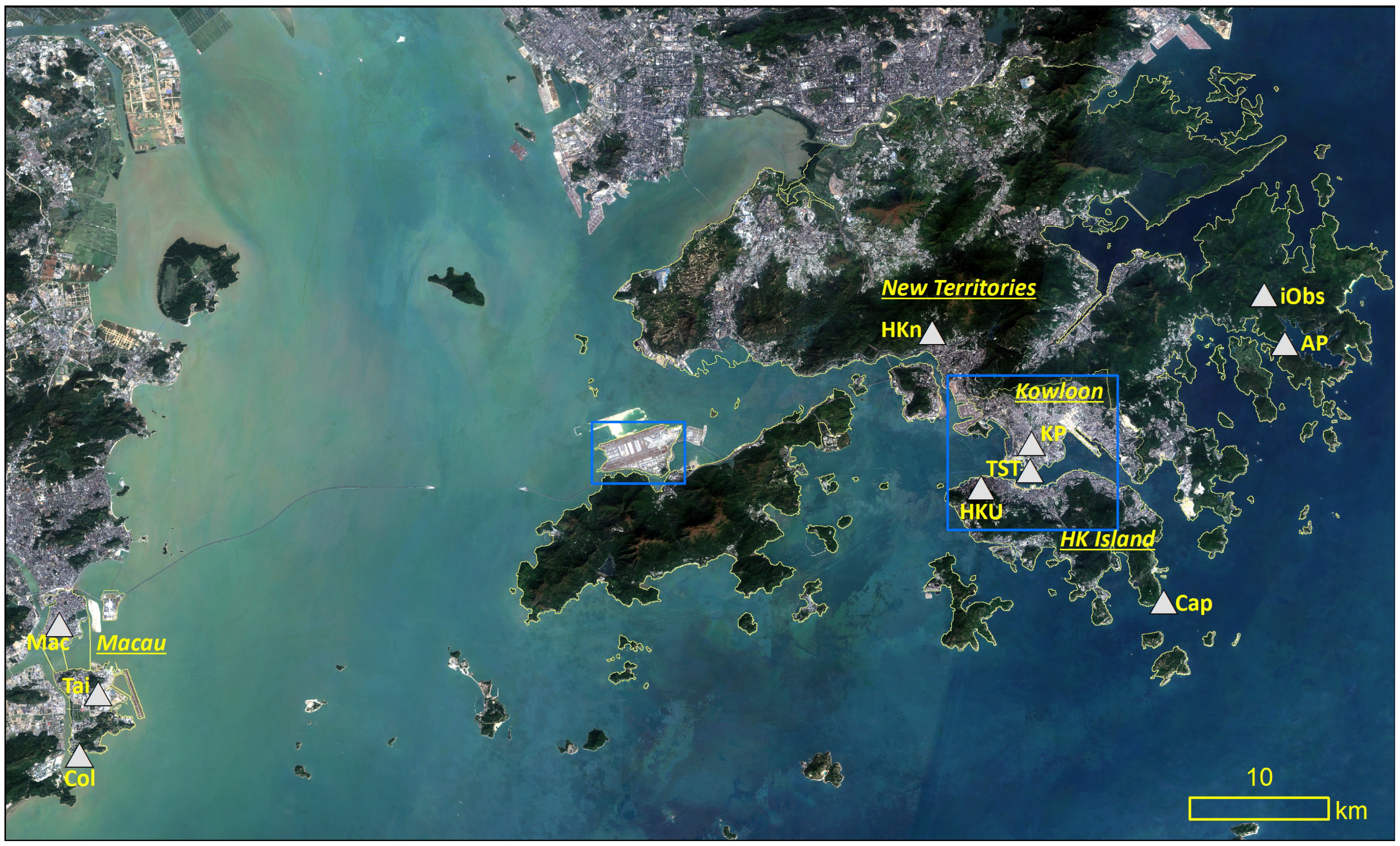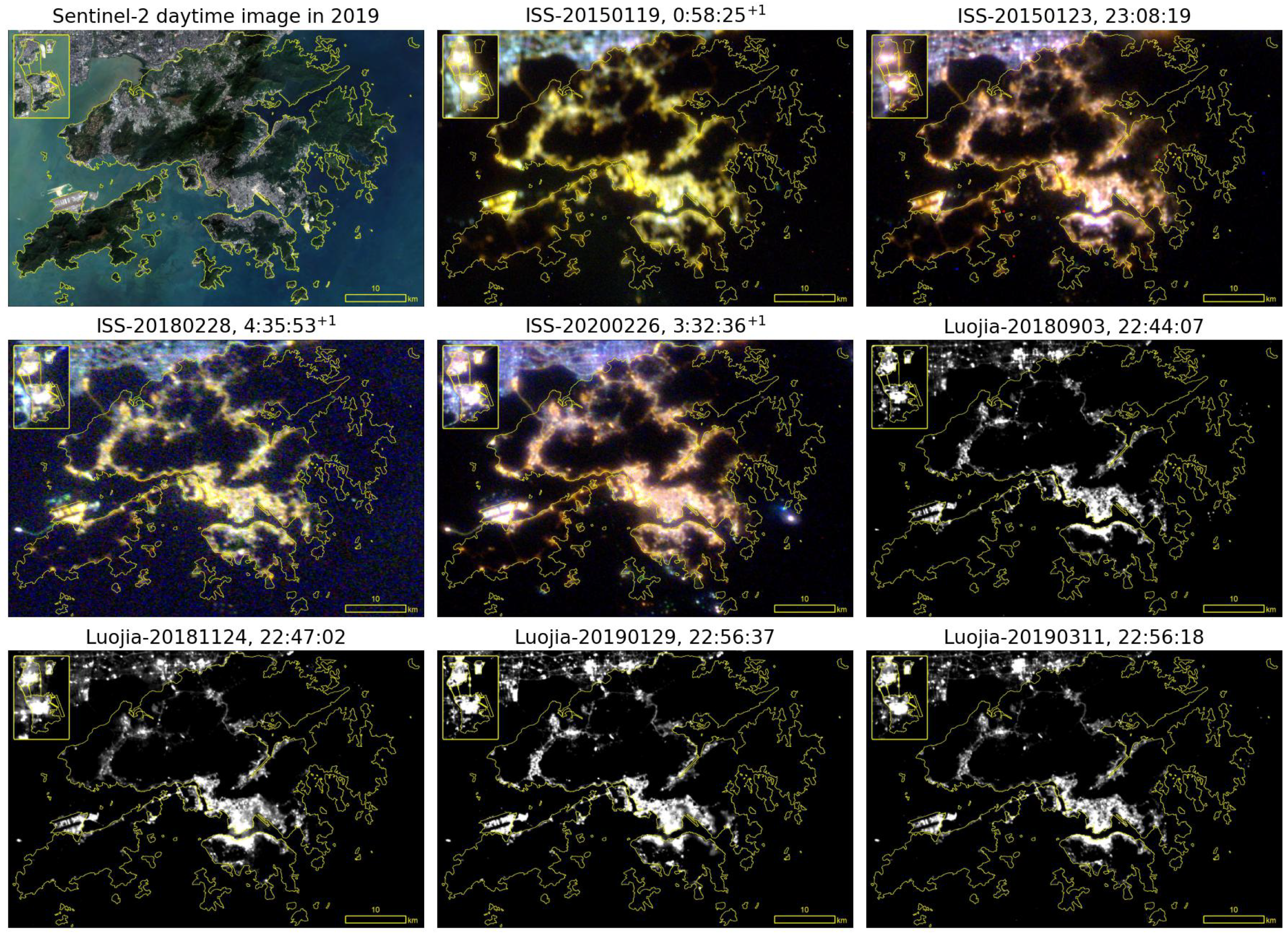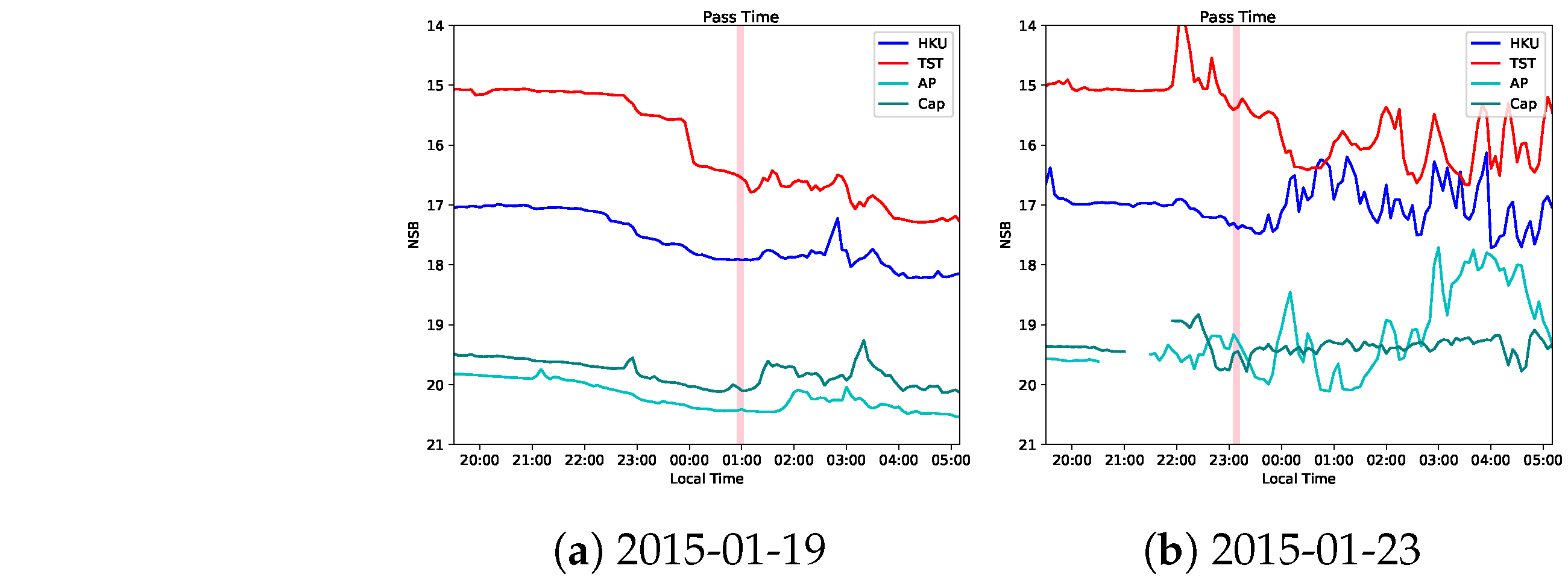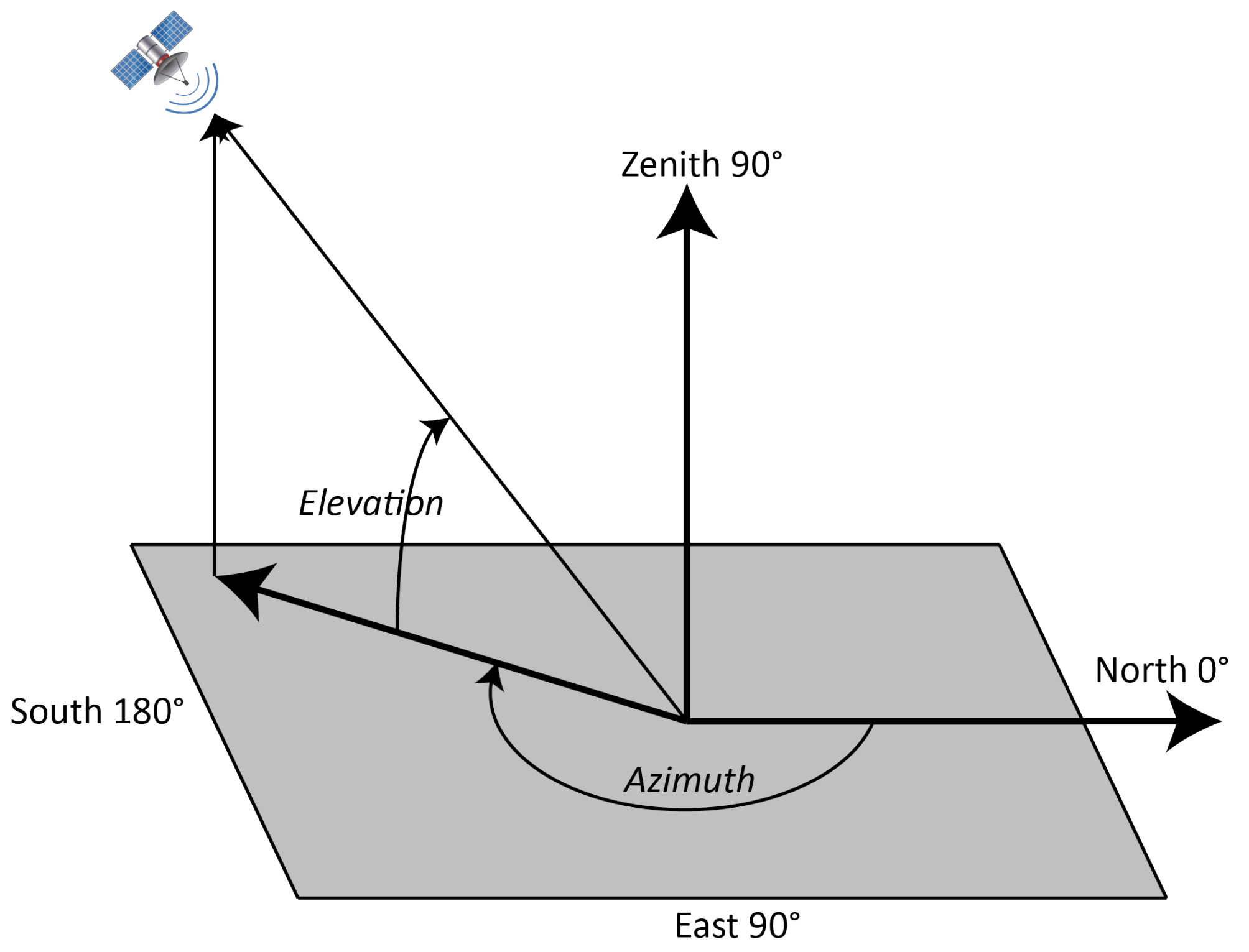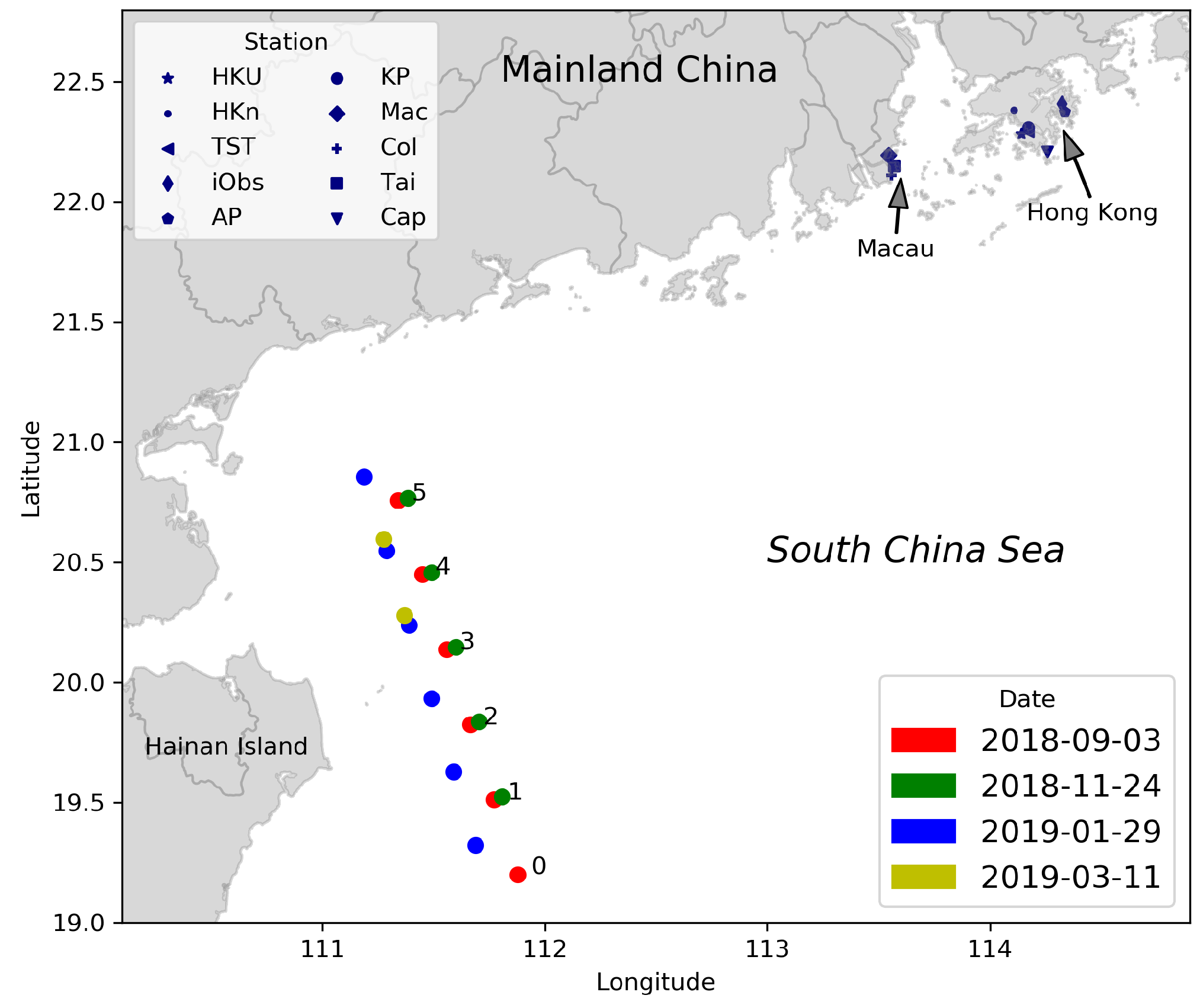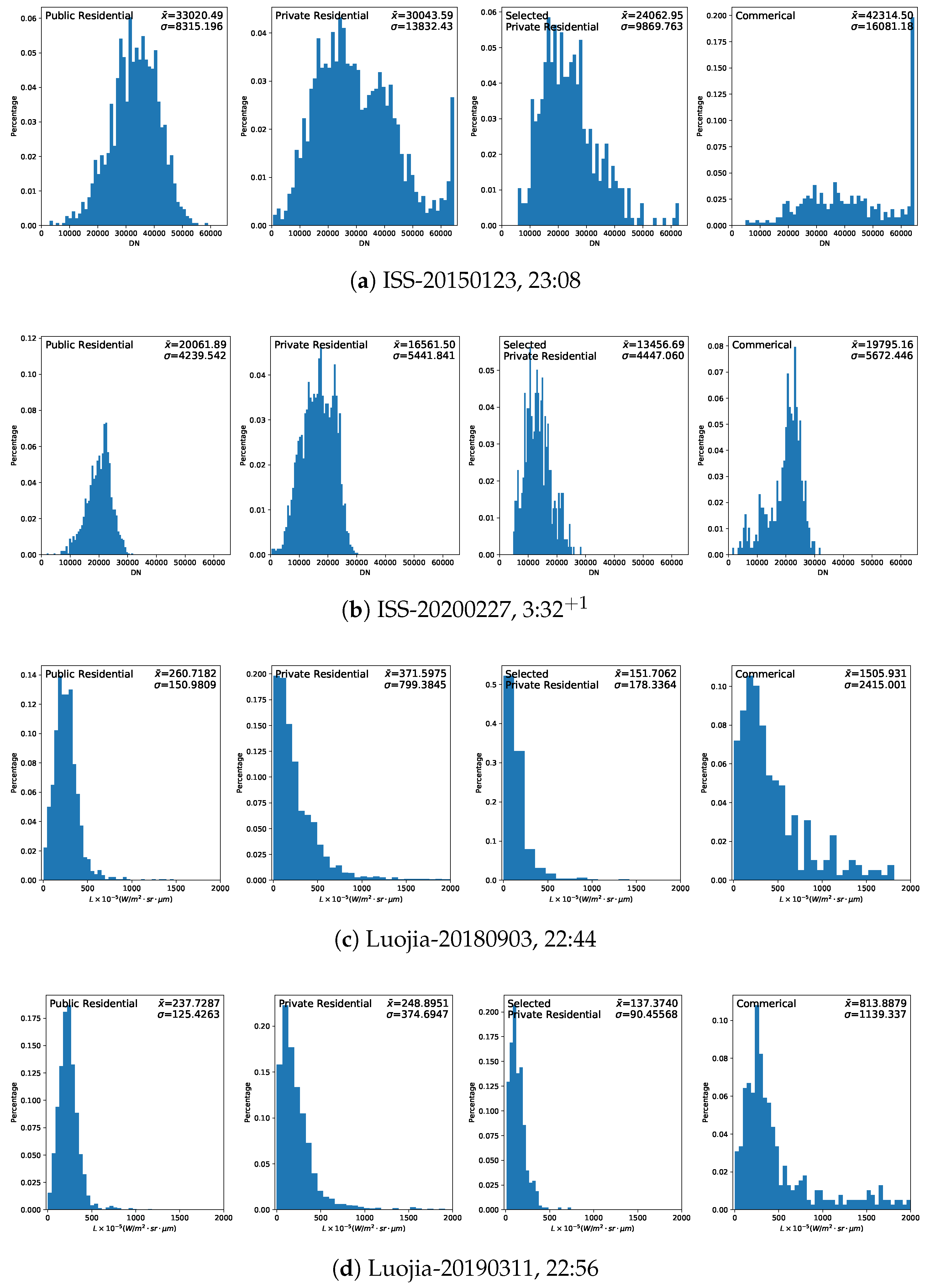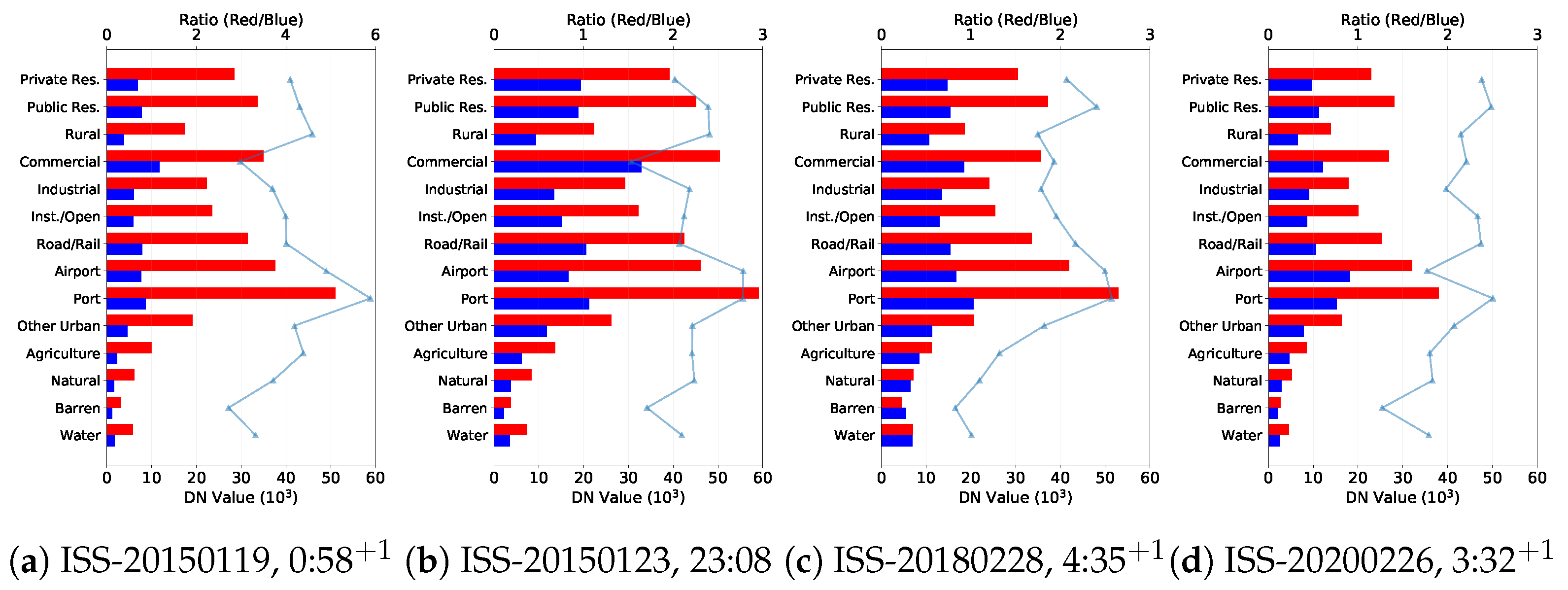1. Introduction
As a result of rapid urbanization in recent decades, urban areas now occupy approximately 3% of the Earth’s land surface [
1], while this number may appear modest, it represents a substantial transformation of our planet, with its environmental consequences extending far beyond this spatial footprint. One of the most pervasive effects is the rise of artificial light at night (ALAN), resulting in a 10% yearly brightness increase in night sky background between 2011 and 2022 [
2]. Consequently, over 99% of the global population now lives under a light-polluted night sky [
3]. Among the world’s urbanized areas, Hong Kong—along with the Greater Bay Area, home to a population of 86 million in South China—is one of the most light-polluted metropolitan areas in the world [
4,
5,
6].
Satellite imagery from outer space can monitor the Earth’s changing nighttime profile. One of the earliest satellite projects, the Defense Meteorological Satellite Program/Operational Linescan System (DMSP/OLS), enabled the first-ever large-scale monitoring of the nighttime Earth dating back to 1992 [
7,
8,
9]. Using these data, researchers have identified strong correlations between nighttime lights (NTLs) and various socioeconomic indicators, including population density, economic development, and energy consumption [
10,
11,
12]. However, as one of the earliest satellite missions, DMSP-OLS data has two major limitations: (a) data storage is constrained to 6-bit binary, with values ranging from 0 to 63, and (b) the lack of on-board calibration means that all values are relative [
13]. Its successor, the Visible Infrared Imaging Radiometer Suite Day/Night Band (VIIRS/DNB), addresses these limitations by increasing data storage to 16-bit and incorporating on-board calibration using a solar diffuser system [
14]. However, its spatial resolution—approximately 742m at the Equator—still poses challenges for detailed analysis within urban areas [
5].
With enhanced sensor technology, the past decade has seen the development of numerous nanosatellites specifically designed for NTL monitoring [
15,
16]. In 2018, Wuhan University launched a small satellite, Luojia-1, capable of capturing NTL data at a ground sampling distance (GSD) of 130 m [
17]. The Jilin-1 satellite achieves even finer resolution, with a GSD of 0.92 m [
18]. Beyond conventional satellite systems, the International Space Station (ISS)—the often-overlooked and largest human-made satellite—occasionally provides high-resolution RGB imagery captured by astronauts using digital cameras [
19,
20]. Leveraging this new generation of satellite imagery, a variety of novel applications have emerged to analyze the nighttime Earth, including studies on housing prices [
21], urban expansion [
22], ghost cities [
23], housing vacancy [
24], urban structures [
25], and freight traffic [
26].
A basic assumption of existing studies is that brighter regions in satellite imagery indicate more human activities at night, while in general, this assumption should hold, there are other factors, often playing a dominant role, influencing the NTL data and their observations. To begin with, some economic activities create disproportionate NTL signals, such as gas flaring in Siberia [
27]. Although NTL data have demonstrated good correlations with economic developments, evidence is often based on past experiences over the last three decades, primarily with the rise of developing countries in Asia [
9]. Other studies have shown a break in such a relationship in East European and post-Soviet countries, where a stable or declining population corresponds to stable and increasing NTLs [
28]. Scale is another problem. As most conclusions are drawn based on the coarse-resolution DMSP/OLS or VIIRS/DNB data, they may be only representative at the country level and may not apply to the city scale [
29]. Apart from the socioeconomic factor and the scale problem, other physical factors such as angular effects, aerosols, and relative humidity all have an influence on the NTL data observed from outer space [
5,
30,
31,
32].
As research on NTL continues to advance, a critical question remains, as in other areas of remote sensing: how can we effectively ground truth observed NTL data, a challenge that remains unresolved [
9,
15,
29,
33]. On the ground, sky quality meters (SQMs, Unihedron, Grimsby, ON, Canada) have been widely deployed to measure the brightness of the night sky [
34,
35,
36,
37,
38]. Several studies have examined the correlation between SQM measurements and satellite-observed NTL data, reporting a wide range of correlation coefficients, from 0.34 to 0.77 [
29,
39,
40,
41]. Notably, the strength of the correlation appears to vary considerably depending on the ambient brightness of the area. For instance, Ref. [
41] found that, when analyzing coarse-resolution DMSP data, only SQM readings darker than 19
showed strong correlations with diffuse light emissions. This finding is consistent with other studies [
42,
43,
44], which also reported stronger relationships between satellite observations and ground measurements primarily in relatively dark environments. However, these studies have been predominantly based on coarse-resolution satellite data. Research on medium-resolution observations, such as those from Luojia-1 and the International Space Station (ISS), remains limited. Given that conclusions often differ depending on spatial resolution, addressing this gap is increasingly important. Furthermore, because these studies rely on data from sun-synchronous satellites, their analyses are constrained to observations captured at approximately the same local time (around 2 a.m.). As a result, temporal variations in NTL within a single night have largely been overlooked [
33].
Multitemporal information within a single night is critical for NTL studies, as nighttime activities are known to vary substantially over time. In Hong Kong and other major metropolitan areas across East Asia, decorative lighting on buildings—a primary source of NTL—is often turned off after 10 or 11 p.m. [
6,
16,
34]. However, these early-night lighting activities are not captured by data from either DMSP or VIIRS satellites, due to their fixed local overpass times. Understanding the contributions of different land use types to NTL emissions is a central question in the field. Several studies have attempted to quantify these contributions using land use data [
45,
46,
47]. For instance, using a panoramic image from EROS-B with a ground sampling distance finer than 1 m, Ref. [
45] found that land use types explained 89% of the variability in NTL, with arterial roads, commercial areas, and service areas identified as the brightest sources. In Berlin and Massachusetts, multi-family residential and commercial areas were found to contribute the most to NTL emissions, while in Shanghai, commercial areas dominated, and in Quzhou, a smaller city in China, transportation facilities were the primary contributors [
47]. Global studies consistently identify commercial and transportation-related land uses as major sources of NTL. However, because these conclusions are drawn primarily from data collected after midnight—when many commercial activities have ceased—analyzing NTL data from earlier in the night and across multiple time points is essential for developing a more comprehensive understanding of nighttime urban dynamics.
In this study, we conduct a comprehensive analysis using multi-temporal imagery from Luojia-1 and ISS to analyze NTL, primarily from two aspects.
First, we analyze the relationship between NTL data and ground-based NSB data across two multitemporal datasets. We find that even uncalibrated ISS images can achieve good agreements with NSB, and we find that the consistency across images taken within seconds is not as perfect as we thought.
Second, we analyze the changing NTLs overnight across land use categories in Hong Kong, identifying categories that contribute the most NTLs. We highlight the necessity of analyzing NTLs at different local times that most sun-synchronous data cannot fulfill.
The remainder of this paper is organized as follows. In the next section, we introduce the study area, the satellite data, and the NSB data. We then present methods used in this study in
Section 3. In
Section 4.1, we show the correlation between field and remote sensing data and analyze the changing NTL data across different hours from the two satellite sources in
Section 4.2. Finally, we draw conclusions and provide discussion in
Section 5.
5. Discussion and Conclusions
5.1. Findings and Strengths
In this paper, we presented a comprehensive analysis of remotely sensed nighttime lights (NTLs) using multi-temporal imagery from the Luojia-1 and International Space Station (ISS), two medium-resolution satellite data sources. We first tested the correlations between remotely sensed NTL data and night sky brightness (NSB) measured on the ground. Our results show moderate to strong correlations, with the Luojia-1 data over Hong Kong and Macau from four different dates in 2018–2019 yielding a correlation coefficient of . For individual ISS imagery in 2015–2020, correlation coefficients ranged from 0.8 to 1.0. We observed notable differences in correlation by color channel, with the best correlations found in the blue channel and the weakest in the red channel.
Our further analysis highlights that NTL data changes throughout the night. In the early hours (before midnight), commercial areas are the brightest land-use category. These areas also appear bluer compared to other land-use types. After midnight, port facilities and airports become the brightest as commercial lighting diminishes. These areas also appear redder than other zones in the city. We also observe considerable heterogeneity in NTL across different residential areas, with mixed-use buildings (tong lau) being the brightest, followed by public housing. Private residential areas, associated with higher incomes, exhibited the least exposure to excessive lighting.
The usage of multi-temporal imagery from various local times makes this study possible, as existing sun-synchronous satellites can only obtain data at similar local times (2 a.m., for example). The comparison of two data sources, from their consistencies and differences, expands our understanding of NTL variations. The differences that occur among images obtained even seconds apart may expand considerable discussion and further analysis arising from this study.
5.2. Further Considerations and Limitations
There are a lot of factors that can affect the NTL values (
Table 6). First, with the addition and removal of light sources, NTL values change as a reflection of real changes—the fundamental assumption of NTL data. However, real changes can also occur with the replacement of light sources; for example, switching from incandescent bulbs to LEDs. This may represent a real brightness change or a change in spectrum [
49,
62,
63,
64]. It remains an open question what the gold standard in brightness measurement should be: the value from a lux meter, the value closest to human perception, or something else? Most satellite sensors have a spectral response different from that of human eyes, and as of today, the debate continues. A standard, however, should be reached within the research community in the era of color remote sensing of NTLs [
19,
36,
63].
Observation angle is another known yet complex factor. The directional effects of NTL call for additional angular correction [
30,
31]. But unlike daytime remote sensing, NTL exhibits more complicated directional effects, especially in cities [
65]. In our study, we have detailed how the observation angle has changed significantly along satellite trajectory. Yet, due to the medium-resolution nature, and the lack of 3-D building data to properly model the urban canopy, we did not provide quantitative analysis. In the current literature, so far, although specific corrections and investigations have been discussed and specially handled in several studies [
66], a universal solution for large-scale application is still pending in NTL research due to the complexity of this factor.
Some other known factors, often too complex to discuss in detail, include moonlight and atmospheric conditions such as PM2.5 and humidity that do not block NTL transmission [
5,
67,
68]. These factors, in addition to the changing observation angle across snapshots taken within seconds, contribute to the imperfect correlations between such snapshots. As we observe better agreement in urban environments (
) than in natural environments (
), natural factors likely dominate.
5.3. ISS Imagery for Artificial Light Research
The ISS image repository has long been considered a valuable source for artificial light research [
69], but it has not been used in practice until recent years [
19,
20,
53,
70]. One of the major concerns is its lack of radiometric calibration. In this study, we show that even without radiometric calibration, the ISS images still present high potential for artificial light research in a relative comparison fashion. Within an ISS image, the color comparison can be done relatively, and we saw a consistent, reasonable trend from land use lighting patterns in Hong Kong. Even so, in a cross-scene validation, the agreement between NSB and ISS is on par with the agreement between NSB and Luojia-1 (a calibrated data source). When calibrated data are not available, directly using the uncalibrated ISS images can be a starting solution to further our understanding of artificial light in cities.
We should note the limitations coming from using uncalibrated ISS images. First, as the ISS images were uncalibrated, their direct cross-comparison should be treated carefully. Second, there are also some other additional considerations, including flat-field correction and spectral response. In our analysis, as the study area is relatively small compared to the entire image, and we have georeferenced the image data carefully, factors related geometric correction remain but should be largely handled. The ISS images we used were captured by Nikon D4 and D5, and it is reasonable to assume that their spectral response should be similar [
19]. But the spectral response is different with SQM [
71] and Luojia-1 [
51]. Yet, as the ISS-NSB agreement is on par with and even better than the agreement between Luojia-1 and NSB, the limitations mentioned here may not be as critical as we thought. Nonetheless, using uncalibrated ISS images is sufficient for our study that is large scale and across multiple years, but for a strictly rigorous and granular study, these limitations should be handled properly.
5.4. Conclusions and Future Directions
In conclusion, our study provides a comprehensive analysis of multi-temporal NTL changes over the night as observed from medium-resolution satellite data. We emphasize the importance of using multi-temporal data to analyze changing NTL patterns in cities, particularly in Hong Kong, one of the most light-polluted cities globally. By analyzing NTL data across different times of the night, we identified significant variations in NTL across land use categories, especially commercial areas. As NTL data are influenced by socioeconomic factors, physical characteristics, sensor parameters (e.g., spectrum and spatial resolution), and the changing position of satellites, conclusions drawn from these analyses should be interpreted with caution. Future studies exploring the scale, color, and potential multi-angle analysis on the same night would contribute significantly to understanding NTL sources and their broader socioeconomic implications.
